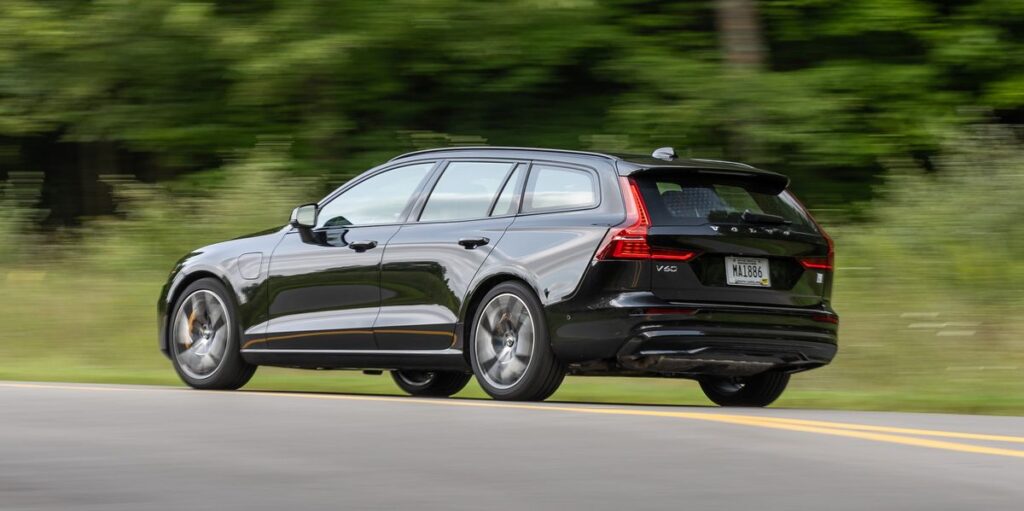Tested: 2024 Volvo V60 T8 eAWD Polestar Engineered Outruns the Past

Volvo got a whole lot right when it debuted the latest generation of the Polestar-massaged V60 station wagon. However, the plug-in hybrid proved a little light on EV range, and its performance couldn’t match that of its gas-only predecessor. Now, with a few extra tweaks under the skin, the revitalized V60 T8 eAWD Polestar Engineered is finally putting down some solid figures.
The upgrades to the V60 Polestar’s plug-in-hybrid powertrain are shared with the other Volvo models carrying the same underpinnings. The battery picks up a third row of cells, boosting usable capacity from 9.1 to 14.9 kilowatt-hours. At the same time, the electric motor powering the rear axle gets a bump from 87 to 143 horsepower. It also contributes 228 pound-feet of torque. Because of the added electrical oomph, the formerly turbo- and supercharged 2.0-liter inline-four has surrendered its supercharger. The revised turbo-only mill makes a healthy 312 horses and 295 pound-feet on its own, and total combined output is now a meaty 455 ponies and 523 pound-feet of torque, respective improvements of 40 and 29.
HIGHS: Impressive EV range, solid hybrid performance, did we mention it’s a wagon?
That increased battery capacity should give the electric-only range a big boost, and it does. In our 75-mph highway cruise test, the 2024 V60 Polestar managed 44 miles of EV range, besting its Volvo-estimated range of 41 miles in Pure mode and absolutely trouncing the 2020 model’s 21-mile highway test result. Overall fuel economy on our 200-mile highway loop is up, as well, from 31 mpg to 34. Charging from empty to full—a typical use case for a PHEV—will take five hours, at best, on 240-volt Level 2 charge equipment. That’s okay for overnight home refills but too slow for midday top-ups. We blame Volvo’s puny 3.7-kW onboard charger, a component they should have upsized when they enlarged the battery but didn’t.
Giving the rear-axle electric motor a little extra juice finally puts the V60 Polestar ahead of its gas-only forebear. At 4.1 seconds to 60 mph, the 2024 model pulls ahead of a 2017 V60 Polestar we tested by one-tenth of a second; it bests the 2020 PHEV by three-tenths. A 12.5-second, 111-mph quarter-mile sprint tops the previous V60’s 12.9-second, 107-mph result. The 2024 V60 also improves on the 2020 model’s 50-to-70 passing time, shrinking it from 3.4 seconds to 3.2. In the opposite direction, the V60 slams to a halt from 70 mph in 163 feet and from 100 mph in 331 feet.
The V60 Polestar’s demeanor varies between sedate and seething, depending on which mode it’s in. Leave everything in the default settings, and the wagon will prioritize electric driving, lolling quietly down the road until juice runs low or the right pedal gets pushed in anger—a clever icon on the digital cluster’s power gauge marks the point where more throttle will engage the engine. People who want to save juice for city driving will be happy to find settings to either hold or generate charge while driving. The only real complaint here is that the center console’s mode switch is gone, now requiring a few taps of the center display to find and change these settings.
LOWS: Slow AC charging, modes buried in menus, limited front-row storage.
Polestar driving mode puts the full force of the powertrain to work, with the gas engine working the front wheels while the e-motor propels the rears. Volvo’s turbocharged engine is demure, preferring a subtler sort of racket that avoids the snap-crackle-pop theatrics of other hi-po powertrains. The eight-speed automatic transmission never makes itself known, and the blending between gas and electric propulsion is buttery smooth. Brake regeneration can be activated by shifting the wagon into B instead of D, and it’s strong enough to bring the whole show to a halt.
Adjusting the V60 Polestar’s suspension involves more than a few taps on a display. The standard Öhlins dampers are adjustable, yes, but only through the knobs on the top of each strut. The default stiffness is on the firm side of the spectrum, but a softer ride is just a few clicks away. As it comes from the factory, the V60’s ride is stern, nicely transferring weight between the corners as it’s chucked down a twisty two-lane while avoiding the kind of bad-road porpoising you can get in a car like the BMW M3 CS.
Despite design cues that are on the mature side, the Volvo wears its style well. Both the interior and exterior lack the kind of trendy drama that leads a vehicle to look old later down the line. The front half of the cabin is cozy but not claustrophobic, although there’s a distinct lack of storage beyond the door pockets. The rear offers suitable space for adults too. One part of the interior that has been zhuzhed up over time is the infotainment system, which now runs on Google underpinnings and includes baked-in features such as Google Maps and Spotify, in addition to the usual smartphone mirroring.
Even More Zippy Wagon Content
VERDICT: Volvo’s wünderwagen makes an even better case for itself.
At $72,345 to start, our V60 Polestar test car is not a cheap proposition. However, stepping up to the next tier of sporty wagons—a segment run by the likes of the Audi RS6 Avant and Porsche Panamera Sport Turismo—requires a six-figure outlay and places a far greater priority on pure performance. If you’d rather strike a balance between sprightly back-road antics and emissions-free commuting, the V60 Polestar will give you both without feeling compromised.
Arrow pointing downArrow pointing down
Specifications
Specifications
2024 Volvo V60 T8 eAWD Polestar Engineered
Vehicle Type: front-engine, front- and rear-motor, rear/all-wheel-drive, 5-passenger, 4-door wagon
PRICE
Base/As Tested: $72,345/$72,925
Options: Luggage cover, $380; power tailgate, $200
POWERTRAIN
Turbocharged and intercooled DOHC 16-valve 2.0-liter inline-4, 312 hp, 295 lb-ft + 2 AC motors, 46 and 143 hp, 133 and 228 lb-ft (combined output: 455 hp, 523 lb-ft; 14.9-kWh lithium-ion battery pack; 3.7-kW onboard charger)
Transmissions, F/R: 8-speed automatic/direct drive
CHASSIS
Suspension, F/R: control arms/multilink
Brakes, F/R: 14.6-in vented, grooved disc/12.6-in vented disc
Tires: Continental Premium Contact 6
235/40R-19 96W Extra Load VOL
DIMENSIONS
Wheelbase: 113.1 in
Length: 188.1 in
Width: 72.8 in
Height: 56.3 in
Passenger Volume, F/R: 51/42 ft3
Cargo Volume, Behind F/R: 61/26 ft3
Curb Weight: 4494 lb
C/D TEST RESULTS
60 mph: 4.1 sec
100 mph: 10.0 sec
1/4-Mile: 12.5 sec @ 111 mph
Results above omit 1-ft rollout of 0.2 sec.
Rolling Start, 5–60 mph: 4.5 sec
Top Gear, 30–50 mph: 2.5 sec
Top Gear, 50–70 mph: 3.2 sec
Top Speed (gov ltd): 113 mph
Braking, 70–0 mph: 163 ft
Braking, 100–0 mph: 331 ft
Roadholding, 300-ft Skidpad: 0.90 g
C/D FUEL ECONOMY
Observed: 27 MPGe
75-mph Highway Driving, EV/Hybrid Mode: 86 MPGe/34 mpg
75-mph Highway Range, EV/Hybrid mode: 44/540 mi
EPA FUEL ECONOMY
Combined/City/Highway: 31/30/33 mpg
Combined Gasoline + Electricity: 74 MPGe
EV Range: 41 mi
C/D TESTING EXPLAINED
Senior Editor
Cars are Andrew Krok’s jam, along with boysenberry. After graduating with a degree in English from the University of Illinois at Urbana-Champaign in 2009, Andrew cut his teeth writing freelance magazine features, and now he has a decade of full-time review experience under his belt. A Chicagoan by birth, he has been a Detroit resident since 2015. Maybe one day he’ll do something about that half-finished engineering degree.







